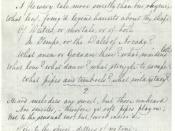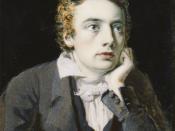Keats composed the 'Ode on a Grecian Urn', based on a sonnet written by Wordsworth in 1811.
The theme of transience and permanence, which struck Keats in Wordsworth's poetry, forms the leading theme in the Odes. The ode, 'To Autumn', may be seen as a temporary 'bridge' in the debate between the two states, in this case symbolised by the seasons. A reprieve is achieved, although the problem is not solved,
"Where are the songs of Spring Ay, Where are they?
Think not of them..."
In 'Ode to a Nightingale' the permanent element is the bird's song, and the emphasis is on the beauty of this, and the bird's rural setting. The bird is subject to change, but does not appear to be in the poem, the bird is unseen and only identified with its eternal song. The real victims are the men who:
"Sit and hear each other groan"
There are hints that the nightingale's song symbolises poetry itself, especially in the fourth stanza where there is an apparent reference to Edmund Spenser, once Keats's favourite poet.
In 'Ode on a Grecian Urn' a comparison is seen as being between 'life (which is transient) and Art (which is permanent). There is a 'teasing' illusion of life as the scene on the urn - but all its celebratory and amorous activities will never carry on to any conclusion. Permanence exacts its price, the painted scene will outlast outlandish passion, the sorrowful heart and (like the image in 'Ode to a Nightingale') the fevers men die of. But it is cold and has an aesthetic message that is uncompromising and elusive, as Keats later showed in 'Ode on Melancholy'. However, if the last two lines of 'On a Grecian Urn' are taken as...


